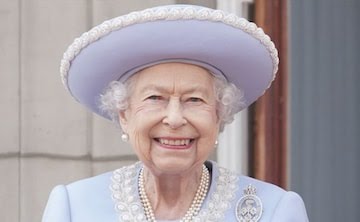Queen Elizabeth II Has Died

The death of the Queen represents the loss of one of the most immediately identifiable symbols of “Britishness” on earth and the end of the second Elizabethan age.
Queen Elizabeth II — monarch of the United Kingdom, sovereign to 14 other realms, head of the Commonwealth, supreme governor of the Church of England, and an iconic figure in global public life for some three-quarters of a century — has died, Buckingham Palace announced Thursday. She was 96.
“The Queen died peacefully at Balmoral this afternoon,” the royal family said in a statement. “The King and The Queen Consort will remain at Balmoral this evening and will return to London tomorrow.”
Upon news of her death, the flag was lowered atop Buckingham Palace in London, where mourners had already begun gathering. Per royal custom, a framed copy of the death announcement was placed on the gates of the palace. The BBC also began playing the British national anthem and aired an image of the late queen.
The new King also released a statement in which he said his mother's death was a moment of the greatest sadness for me and all members of my family.
READ ALSO » Dubai Has Banned Visa Application For Nigerians Over Recent Fight In Satwa
We mourn profoundly the passing of a cherished Sovereign and a much-loved Mother. I know her loss will be deeply felt throughout the country, the Realms and the Commonwealth, and by countless people around the world, the King said. During this period of mourning and change, my family and I will be comforted and sustained by our knowledge of the respect and deep affection in which The Queen was so widely held.
The royal family had announced earlier on Thursday that doctors were “concerned” for the Queen’s health and had placed her under medical supervision at Balmoral Castle in Scotland. Her children and grandchildren had traveled to be with her.
The monarch was last pictured by a photographer on Tuesday at her Scottish residence, where she met with Liz Truss to invite her to become prime minister. Truss and outgoing prime minister Boris Johnson had journeyed to Scotland, rather than Buckingham Palace in London, because doctors had advised the Queen not to travel.
In a speech outside 10 Downing Street on Thursday evening, Prime Minister Truss said it was a day of great loss, describing the late queen as the rock on which modern Britain was built.
Our country has grown and flourished under her reign, Truss said. Britain is the great country it is today because of her.
Having reigned for more than 70 years and through the premierships of 15 British prime ministers — starting with Winston Churchill's second term — she was the longest-serving British monarch and, until her death, the longest-serving head of state on the planet.
Due to the stunning longevity of Elizabeth’s reign, only a minority of people alive can vividly remember life as it was before her 1952 ascension. For decades, she endured as a steady presence — whether in ceremonial pageantry or Christmas Day speeches, seen waving from carriages or in profile on the back of currency — as the world around her changed in dizzying ways.
During her decades in power, Elizabeth oversaw much of the effective decolonization of the British Empire and its evolution into the present-day Commonwealth of Nations. She saw the UK slide in influence following World War II, but emerge as a 21st-century nation — more diverse, confident, and modern. She saw her subjects live through technological advances, social revolutions, political crises, natural disasters, and a global pandemic. And she saw average women gain more rights, independence, and power, and three serve as her prime minister — one of whom, Truss, was born 23 years after Elizabeth first assumed the throne.
And yet, in her ancient role of duty and tradition, she personified Britain’s id, its underlying self-sense of historical grandeur, to the world. Her death represents the loss of one of the most immediately identifiable symbols of “Britishness” on earth and the end of the second Elizabethan age.
In February 2017, Elizabeth became the first British monarch to reach a sapphire jubilee, a historic milestone she celebrated with little fanfare. “It is a testament to her selfless devotion to the nation that she is not marking becoming the first monarch to reign for 65 years with any special celebration,” then–prime minister Theresa May said at the time, “but instead getting on with the job to which she has dedicated her life.”
Five years later, in 2022, she eclipsed that record again by marking 70 years on the throne. You laugh and cry with us and, most importantly, have been there for us, for these 70 years, Prince Charles, her eldest son, said in a speech outside Buckingham Palace to celebrate the platinum jubilee. You have been with us in our difficult times. And you bring us together to celebrate moments of pride, joy and happiness.
The Queen’s husband, Prince Philip, the Duke of Edinburgh, died in April 2021 at age 99. Their marriage of more than 70 years made him the longest-serving royal consort in British history. Together, the pair had four children — Prince Charles, Princess Anne, Prince Andrew, and Prince Edward — as well as eight grandchildren and even more great-grandchildren.
The death of the Queen means Charles is now King. His eldest son, Prince William, is now first in the royal line of succession.
Elizabeth Alexandra Mary Windsor was born at 2:40 a.m. on April 21, 1926, at 17 Bruton Street in London’s Mayfair district during the reign of her grandfather, King George V. She was the first child of the Duke and Duchess of York.
When Elizabeth was just 2 years old, Churchill famously remarked that she had “an air of authority and reflectiveness astonishing in an infant.”
She enjoyed a relatively peaceful early childhood with her parents and younger sister, Margaret, who was born in 1930.
The young Elizabeth — known through her childhood as Lillibet — was not initially expected to become Queen. Third in line to the throne behind her uncle Edward, Prince of Wales (later King Edward VIII), and her father, the Duke of York, it was assumed she would only fall further down the line of succession, as Edward was still young and expected to have children of his own.
However, the royal family was thrown into turmoil in 1936 when Edward abdicated the throne to marry American divorcee Wallis Simpson — a move that was seen as incompatible with his status as the head of the Church of England, which at the time opposed remarriages for divorced people whose ex-spouses were still alive.
Edward’s abdication caused a constitutional crisis that led to his brother, Elizabeth’s father — the Duke of York, Albert — being unexpectedly elevated to the throne, becoming King George VI, with Elizabeth the next in line.
